Natural Farming, beyond organic
Food Forests and other Regenerative Solutions
the Future of Agriculture = Mimicking Nature
EVEN BETTER, LET NATURE DO THE WORK
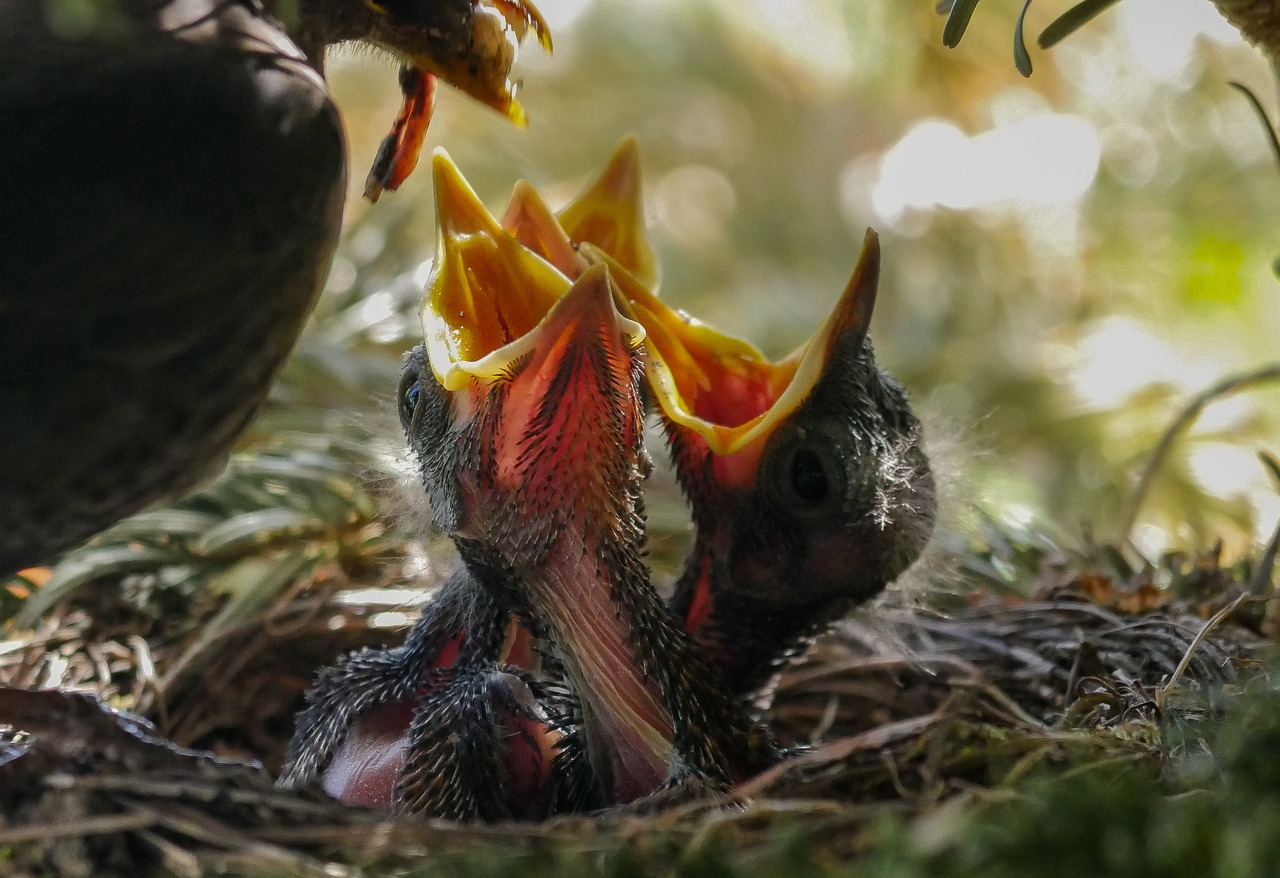
WHY MIMIC NATURE?
It is much more fun!
The last 50 years of working against nature did not bring the results we longed for:
Food + Water Abundance
Nearly 25.000 people die every day (!) of hunger. Over 800 million people are undernourished. Main cause is that subsistence farming is becoming every season more difficult with traditional methods. Topsoil is eroding away: for every ton of grain, 5 tons of topsoil disappears. Half of the planet’s landmass is in danger of becoming desert or barren unproductive land.
The numbers are staggering.
Other causes of famine and poverty are hot wars and trade wars, logistical inconsistencies (discarding of 1/3 of the produce)
Biodiversity & Biomass
It is no news that we are witnessing a mass extinction.
Recent example: insect-populations declined with 75% in North West Europe,
Scientists suspect modern agriculture with pesticides is the main cause.
Climate Resilience
Conventional agriculture is like burning fossil fuel:
Each year, per hectare conventionally cultivated land, 5 – 10 tons of carbon are released into the atmosphere! A normal healthy soil would absorb that amount of CO2 and use it to grow new plants. But plowing of the land, leaving it bare in the sun, rain and wind, and the use of bio-cides destroys soil life and therefore the processes of sequestering carbon.
Learn more: lecture of Australian micro-biologist Walter Jehne in our video-selection.
what do we mean by ‘food forests’?
A Food Forest is a denser version of agro-forestry. Agro-forestry being: the planting of trees and crops in combination.
Agro-forestry can signify also silvio-pastures: keeping live-stock in orchards, on a rotation schedule.
Main requirements are:
– using no poisons (pesticides, chemical fertilizers, GMO)
– keeping the ground covered in mulch or growing plants
– no burning nor plowing
– accelerating growth by succession of the right groups of companion plants (a forest in 6 years instead of 30).
scientifically proven as superior!
a 7 years study by the University of Sao Paulo, showed that with agro-forestry methods, food for 500 people was realized on only 1/6 (!) of the surface conventional agriculture would need for the same amount of people.
namely 70 ha compared to 420 ha conventional!
Detail: with half the costs and with more work satisfaction for the farmers.
viable and economical.
Their conclusion: humankind does not have to take more precious land away from nature (and we might add: nor the other way around, taking precious land of humans away for nature, like agenda 21 proposes).
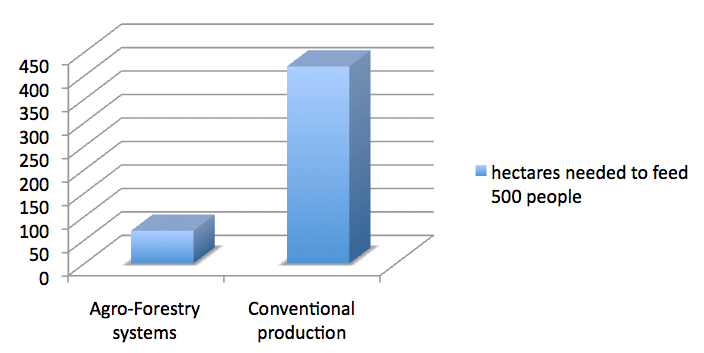
Study: 7 years food for 500 people
Using only 1/6 of the land that conventional would use
70 Hectare of Agro-Forestry with crops, integrated with livestock on so called Silvio-pastures, provided food for 500 people. In conventional agriculture this amount of food would need 420 ha to grow.
Silvio-pastures are grasslands with every 25m2 a tree + every m2 a fodder-bush. Cows are grazed in a rotational system to allow vegetation recover.
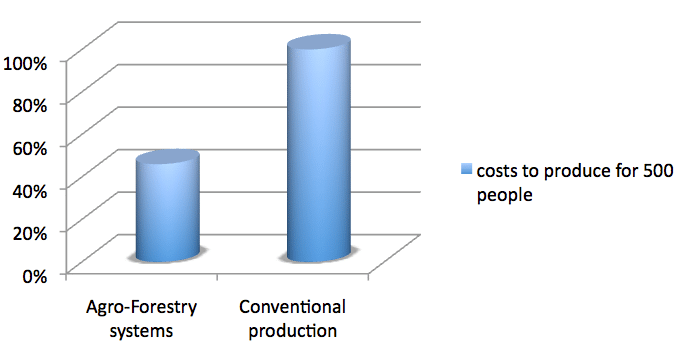
6x times more production
with 54% less costs
Participants told that the quality of their work also greatly had improved.
The scientists concluded that..
” it is possible to increase production to meet the growing food global demand without the need of expanding the agricultural frontier, preserving the remaining forestland “.
Reference
Costa, M.P., Schoeneboom, J.C., Oliveira, S.A., Viñas, R.S. and de Medeiros, G.A.. A socio-eco-efficiency analysis of integrated and non-integrated crop-livestock-forestry systems in the Brazilian Cerrado based on LCA. 2018. Journal of Cleaner Production 171, Pages 1460-1471. [https://doi.org/10.1016/j.jclepro.2017.10.063] Accessed 25 April 2018 at Elsevier: [ https://www.sciencedirect.com/science/article/pii/S0959652617323569# ]
a food forest is not:
A food forest is not a monoculture of one or a few species, be it fruit- or nut- or fodder trees.
A food forest is not planted by invading an existing healthy native forest!
But any existing monoculture (like a eucalyptus plantation) will gradually be replaced with an enormous variety of plant species.
to be honest: The Food Forest method was also chosen due to personal reasons of the LOT team:
It gives us the chance to concentrate on producing plant-based foods. This bypasses ethical struggles for us. It would be traumatic to know that in our project animals would be exploited and butchered, even if they would have had a natural life outside. With all respect, we leave herding to other projects.
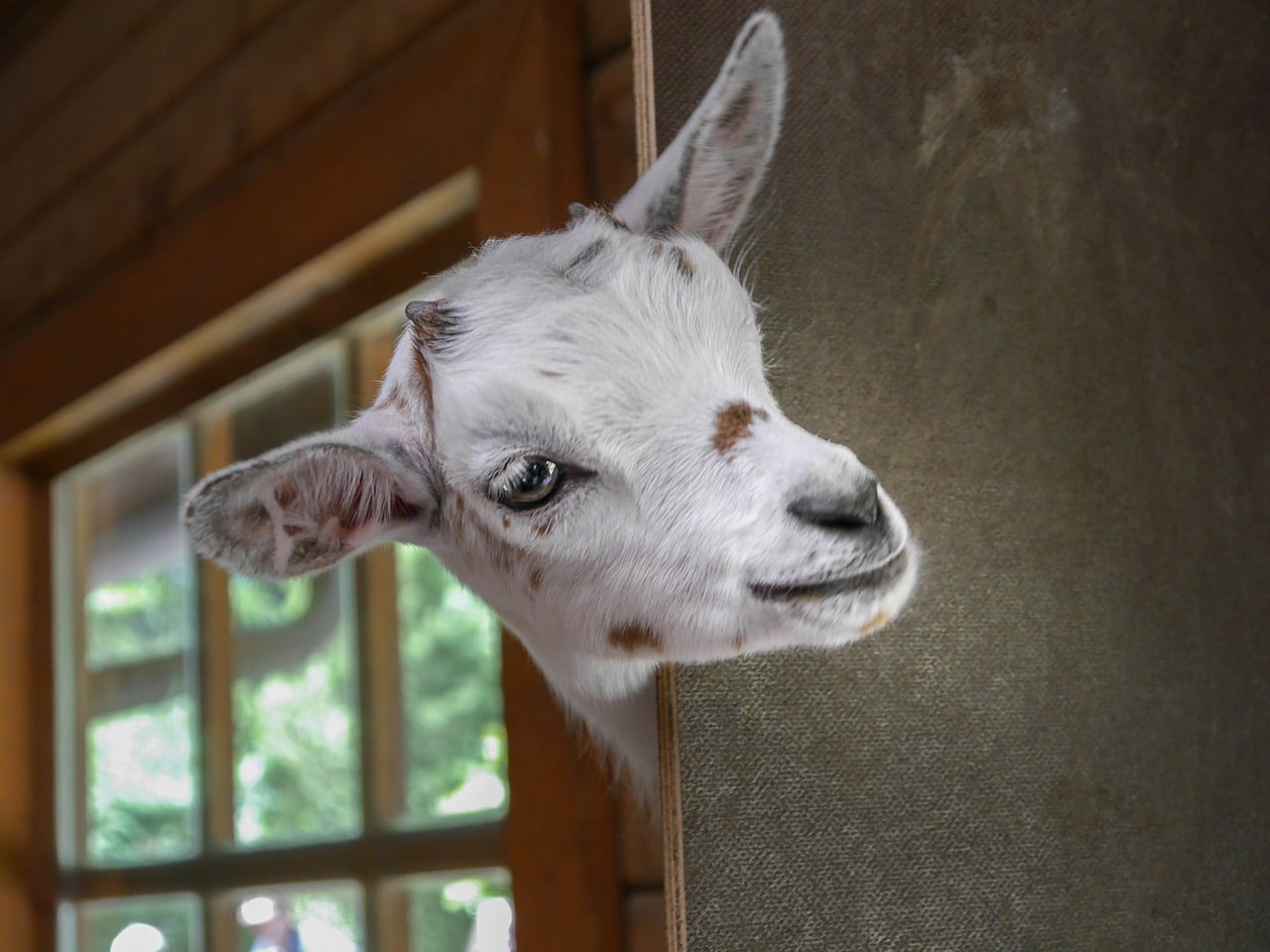 .
.
We do recognize that herding can safe the planet too!
We do recognize that in arid regions well-managed cattle has urgently to do the work of combating desertification, mimicking the large roaming herds of herbivores that kept those areas lush for millions of years. That technique could save the planet much faster than the tedious planting of food forests. See the lectures of Allan Savory on our videos page.
We acknowledge that such roaming grazers have a live according to their nature – so very different from the usual non-life in factory farms !
So when the eventual killing is done swift and on site, it could be an option to provide for people who need meat. So we sympathize with the graziers (those who produce beef in that way) in their competitive battle against factory farms / feedlots where animals ‘live’ under terrible conditions.
Sounds great, but can regenerative farming be done on a “larger than goblin” scale?
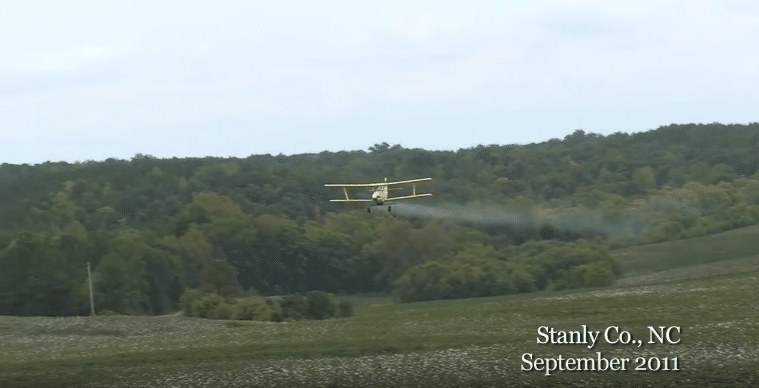
IS SEEDING BY AIRPLANE LARGE ENOUGH?
A group of farmers in the Southeastern US has used no till, no chemical fertilizers, no compost for 30 years. They make no exception on their larger fields of 850 acres (344 ha). Instead they grow mixed cover crops before cash crops. They get much higher yields than the neighbors. i
The trail behind this little airplane is no poison, it is a mixed seed of cover crop species.
Large scale farmers who want to transition towards more regenerative ways, can learn a lot from the experience of this group. For example how they transformed their machinery to flatten the old cover crop and seed the cash crop at the same time.
See the trailer “Under Cover Farmers” on our page with example videos.
In August 2018, as an answer to the algae problem in the coastal waters, the USDA posted an appealing webpage about such method for really modern conventional farmers, because they cause no run off of fertilizers to waterways
Food-abundance, drinking water, biodiversity,
even the weather …
Everything starts in a healthy TOPSoil
There should be a complete zoo in the soil!
The soil should be teaming with life, even more so than above ground.
Because first of all a busy topsoil is a sponge of organic material that absorbs water. Microorganisms build this sponge from decaying plant matter = cellulose made out of carbon, taken out of the atmosphere (the CO2 topic). In an undisturbed covered soil fungi and plants cooperate: fungi feed the plants moist and minerals, in return plants donate sugar and cellulose.
Apart from CO2 there is another 100 times more potent greenhouse gas: methane. For this to break down, there need to be fine moist droplets in the air + sunlight. That fine moist is not provided by bare ground. It only exist where there is slow evaporation from a healthy soil with green plants growing on her.
Thirdly, shade and moist evaporation provided by plants are a major cooling and stabilizing factor in micro-climates. All the micro-climates combined are having a big influence on the weather elsewhere.
We grow the ‘zoo’ in the soil by using the following 9 principles:
We’ve got her covered
The Principles of Regenerative Agriculture:
We don't feed her poisons
No pesticides, herbicides, fungicides and whatever ‘cides’ there exist more. Neither chemical fertilizers.
Reason: all these inputs destroy the soil micro-organisms.
Some regenerative farmers report great successes restoring the soil with a kind of pro-biotics (like we humans take after antibiotics). This is called EM: Effective Microorganisms.
Sterile soil – only minerals and rock particles – does not sequester carbon/ organic material, It compacts and can’t absorb water,
The results: droughts, run offs, erosion and floods elsewhere.
Important other drawback of chemical fertilizers::the mining has devastating effects on the surroundings. It is done by strip-mining, meaning nature is completely destroyed on the site. Then it uses an enormous amount of sweet water. And it leaves a toxic chemical soup on the sites. Dams around this soup do leak and occasionally burst, spreading the toxins for miles.
we don't leave her naked
Always mulch or sow cover crops, also in between your cash crops and under trees.
As soon as soil reaches a temperature above 28 degrees Celsius, the phosphorus binds to aluminum and cannot be used by plants anymore until micro-organisms return with their enzymes to break up this bond. To keep soil cool and moist, protected from sterilizing UV- and infrared and drying wind, we always have to cover with at least 3 inches skin of mulch and growing plants. So we never burn weeds and clippings, we use it as mulch on the beds..
When you have the luxury of wood-chips: they are ideal as mulch on the walkways in between.
Now microbial life can thrive, donating minerals and water to the roots of your crops. The system sequesters a significant amount of carbon out of the atmosphere. If 1/5 of our arable land would be cultivated that way, our fossil fuel emissions would be compensated. And there is another reason how healthy soils can save us from climate change. Learn more in the blog post farming is the most important job at the moment
Synropy method of starting a new growing plot for agro-forestry:
work in rows of two ditches of each 1/2 meter (1.6 feet), with 30cm/ 1 foot wide ridges in the middle. The dryer the plot, the deeper the ditch (max 15cm/ 6 inches, on slopes on contour). Ditches receive a layer of logs first. Then branches and twigs. Lastly 10cm/ 4 inches of normal mulch like leaves and mowed grass. This layer will act like a sponge and fungi fodder. The ridges next to those ditches receive a layer of manure + the leaves/ grass mulch. Planting is done on the ridges, in high density.
Nuance about grasses as perennial over-crop: they can fight desertification much faster than trees. But since they evolved together with herbivores, they have to be mowed or grazed to keep the system dynamic.
Counter-intuitive fact: In arid regions lacking of grazers leads to desertification. This is going on in national parks in the US and has been shown to reverse with well managed grazing. The results are stunning, even after only half a year: gradually streams and lush greenery return .
See a Ted talk by ecologist Allan Savory.
also relevant: one of our blog posts: Nature left alone can degrade!
we leave her in peace, no burning, plowing
After the growing plot was started, no further plowing, hoeing, digging, turning, pulling out. Weeds you cut at ground level, or press down.
There still is debate if it is necessary, while preparing the rows the first time, to unpack the soil (sure without turning it though). Some pioneers get excellent results without loosening. In that case worms and all the carbon-binds loosen the soil in the process.
Our job is keep piling up organic matter from pruning or mowing, like nature does when trees drop their leaves in autumn or the dry season.
Dying roots in the soil and mulch are excellent food for the microbes. They don’t need chemical fertilizers.
Heirloom seeds instead of GMO
Since there is no scientific consensus on the safety of genetically engineered food (1), we’d rather be cautious and only use seeds that were developed by our ancestors over millennia.
The companies that are involved in genetic engineering have shown to invent monstrosities beyond imagination (agent orange, PCB’s) and now want to control the world’s food and drugs supply. See the documentary ‘A match made in hell’ by James Corbett.
GMO is out of the lab since 1990, an ongoing experiment. It facilitated the use of round-up (glyphosate) on a grand scale. This created super weeds which are now a problem for farmers in the US.
We suspect glyphosate is a factor in rising cancer numbers After all, the World Health Organisation defined round up as a class 2a probably human carcinogen, on a par with the infamous DDT. (2)
polyculture with companion plants
Plant an enormous variety, all mixed together. It may look disorderly, but variety gives food-certainty. And don’t forget the cover crops and mulch trees. Not all plants in a farm need to be edible.
A mono culture has only one level of roots and leaves. But nutrients that the plants need, could be available deeper in the ground. A poly culture of different (cover)crops can provide much more nutrients because plants collaborate.
Plants that belong to the same phase supplement each other (e.g. the pioneers). The trick is to put plants of all categories, seasonal and perennial, densely packed together to use all vertical niches:
root vegetables, herbs, leave vegetables, berry bushes, vines, low fruit trees, high fruit and canopy nut trees. You do not need to provide shade nor fertilizers: they support each other.
Weeds are strong pioneer plants. They are cut off close to the soil, their roots are useful in the ground, and their leaves are useful as mulch in between your crops.
accelerated succession
Respect spontaneous pioneer plants and native tree species, even if they are in-edible. They prepare the soil and can survive harsh conditions.
There exists a natural succession in plant species. The earlier plants prepare the soil for the next group. To plant the other way around is senseless.
But the succession can be faster than in nature. When a group of plants gets near their maturity, (but still grows vigorously) you have to prune drastically. As a reaction their roots give off growth hormones and release nitrogen. This will stimulate the next group.
When you observe less than frantic growth in the system, you need to prune more. Apparently some plants are inhibiting growth of the rest because they are trying to create a rest phase.
Chop and drop. Each succession enriches the fertility and increases the moisture-content and stability of the soil. Plants get less stressed with extremes and as a result are less vulnerable for diseases.
You can increase growth 5-fold, so obtain a food forest in 6 years instead of the natural 30 years. See the videos of Agenda Götsch.
Fast regrowth of cut down forests can be reached by selective pruning of the spontaneous regrowth on the tree-stumps. Watch Tony Rinaudo about Farmer Managed Natural Regeneration
rainwater harvesting
Organic agriculture usually needs to irrigate. We strive to harvest so much rainwater into the soil, that there will be no need for irrigation. So one saves time and energy and precious drinking water.
Agriculture is possible without irrigation, even in arid regions!
Most important: keep the ground covered in growing plants or mulch.
Raindrops that fall from an altitude of 2 km onto bare ground are like little hammers pounding the soil into compaction. Result: run-off, erosion, flooding. Flooding in a region is often to be observed after fires that flattened forests nearby on higher level.
Greenery on the other hand acts as bed-springs that slow down the drops, so there is more chance they get absorbed into the ground. From there the water will be slowly released as vapor or via little channels as a spring or creek.
But humans sometimes have to do beaver-work, especially in deserts, to catch every drop.
Before designing a building or a landscape, look at the contour lines and design for water abundance on these lines: construct ditches (swales), ridges/ dams, pitches / ponds, plan roads and ways very well.
:Also plant trees on contour, let the channels meander, etc. There is an intricate landscape to create.
Learn more in a video of Geoff Lawton ‘greening the desert’.
Other example Brad Lancaster: Planting the rain to grow abundance., taught by mr. Zephania Phiri Maseko (1927 – 2015) in Zimbabwe. Culminated in these books:
The Rainwater Harvester by Mary Witoshynsky and Rainwater Harvesting for Drylands and Beyond by Brad Lancaster.
It really is possible, even in very arid regions. Start to learn here:
– The man who stopped the desert (Sahel, Africa), first on our videos page.
and the woodchips/ leaves mulch method ‘Back to Eden gardening’.
nature sows, so do we
Sowing is the most efficient way of planting. Even of trees. there is no need for a nursery. In fact, trees grow stronger and more adaptive if you directly seed them in the rows or isles where you sow your seasonal crops. By the time they come up the vegetables protect them from the elements. The nutrient-exchange in the soil will accelerate growth. Later on there will be no stress of transplant.
See the results from Ernst Götsch in the video Life in Syntropy on our videos page
let animals prepare the land
If you have chickens, let them loosen up the soil 10 days before planting.
At livestock permaculture farms the sequence is: first day the goats, second day the cows, and after 3 days the chickens to clean up the flies and parasites. Then you can plant.
Large herbivores are nomads
Overgrazing = 1 cow for a 100 days on one spot.
Overgrazing is not: 100 cows for one day on one spot, then waiting 99 days to return there!
Having livestock can help in productive ecosystems, but they most be managed carefully. Mimic nature again.
The natural behavior of large herbivores:
* to stay closely together in herds
* to roam over the landscape, moving to fresh vegetation as soon as a field is ‘mowed down’ + urinated and manured all over the place.
* to not come back on the same field for one or two months, depending on the season and thus growth-rate of the vegetation.
In this way Nature sustained the herds AND the plants AND the predators of the herd (like early humans) for millions of years without causing deserts. On the contrary, keeping the large savannas lush and moist.
If one mimics this with cattle nowadays it reverts deserts into green lush moist landscapes again.
Watch an explanation of this principle on our video-page by ecologist Allan Savory
When a farmer in the LOT programm wants to keep livestock, there are contractual requirements for humane treatment though. See the outline here on our site www.korpos.nl/about/#animals-sentient-beings
A healthy soil, covered in growing plants, cools and stabilizes the climate very fast.
We dare say that, as soon as the International Panel on Climate Change finally realizes this, regenerative farming will be seen as the most important profession of our times.
learn more about soil effects
Soil stabilizes the global climate in at least 5 ways:
– she provides growth to plants. Growing plants take CO2 out of the atmosphere
– she stores water that evaporates slowly, cooling the area by the calories each H2O molecule uses
– moist above a healthy soil and greenery + sunshine breaks down methane, a greenhouse gas far stronger than CO2
– healthy soil gives off important bacteria into the air, to which water-vapor molecules attach to become rain clouds (reflecting heat back into space)
– she stops desertification. Desertification is a major cause of climate instability. First of all because of the sheer landmass that is involved by now (half of our landmass is on the brink). Second, bare desert ground reflects a lot of heat which gets trapped in greenhouse gasses. And third it causes dust to rise. This stays in the air as a stretched haze that does not allow clouds/ raindrops to form.
These principles are beyond sustainable and organic,
they are restorative
Agricultural land becomes ecosystem
Such an area produces more food for more biodiversity than even nature would. Mankind can enrich the planet
Let’s Do Something Better Together
Image
Inactive account ID 12019, Africa, desert landscape
Through Pixabay, under creative commons
downloaded 14. July 2018